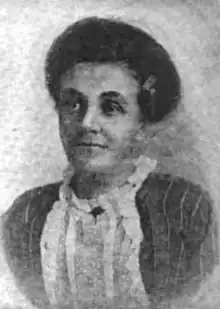Eleanor Blackmore | |
|---|---|
 Eleanor Blackmore, from a 1916 publication | |
| Born | Eleanor Maud Blackmore 17 April 1873 Havant, UK |
| Died | 24 August 1943 Wellington, Somerset, UK |
| Occupation(s) | Baptist missionary and nurse in Nicaragua |
Eleanor Maud Blackmore (17 April 1873 – 24 August 1943) was an English Baptist missionary supported by the Woman's American Baptist Home Mission Society. She helped to establish the first Baptist church and schools in Nicaragua.
Early life
Blackmore born in Havant, near Portsmouth, the daughter of William Blackmore and Maria Blackmore. She trained as a nurse while studying at the Baptist Deaconess Home in Chester.[1]
Career
Blackmore was already working in Central America by 1902, when she went to Costa Rica to assist during a yellow fever outbreak, and nearly died when she contracted the illness herself.[1][2] She was commissioned in 1916 as the first general missionary in Nicaragua supported by the Woman's American Baptist Home Mission Society.[3][4] She began a school in Managua.[5] In 1917 she and José S. Mendoza opened the First Baptist Church of Managua.[6] She helped to lead revival meetings throughout Nicaragua in 1924, with pastors Harry Strachan (father of missionary Robert Kenneth Strachan) and Roberto Valenzuela Elphick of Chile.[7] Her reports from the field often described intense opposition from Roman Catholic leaders and their parishioners,[8] noting, "I am not a pessimist or I would not have stuck at this field for 26 years."[9]
Blackmore attended an international missionary meeting in Edinburgh, Scotland, in 1910.[3] In 1920, she spoke at a convention in Pittsburgh, Pennsylvania.[10] Blackmore retired from the mission field in 1938, and returned to England.[11]
Personal life and legacy
Blackmore died in Wellington, Somerset, in 1943, aged 70 years.[12] Universidad Politécnica de Nicaragua traces its origins in part to Blackmore's co-educational 1917 school.[13]
References
- 1 2 Hull, Eleanor (1975). Women who carried the good news. Internet Archive. Valley Forge, Pa. : Judson Press. p. 52. ISBN 978-0-8170-0651-8.
- ↑ Hayne, Coe (March 1921). "Going Forward with the Book in Nicaragua (part 2)". Missions: American Baptist International Magazine. 12: 146–150.
- 1 2 Anderson, C.; Anderson, Justice (2005). An Evangelical Saga. Xulon Press. p. 445. ISBN 978-1-59781-495-9.
- ↑ "The New Field at Nicaragua" Missions (November 1916): 854. via Internet Archive
- ↑ "The School of the Living Christ" Missions: American Baptist International Magazine 15(April 1924): 216.
- ↑ Smith, Calvin L. (2007-03-31). Revolution, Revival, and Religious Conflict in Sandinista Nicaragua. BRILL. p. 57. ISBN 978-90-474-1935-8.
- ↑ "A Stirring Revival in Nicaragua" Missions: American Baptist INternational Magazine 15(October 1924): 543.
- ↑ Hayne, Coe (February 1921). "Going Forward With the Book in Nicaragua: Dramatic Incidents in the Life of Eleanor Blackmore, a Pioneer in Central America in Perilous Days". Missions: American Baptist International Magazine. 12: 68–70.
- ↑ "Minus Twenty Cents!" Missions: American Baptist International Magazine 15(March 1924): 173.
- ↑ Neisser, Rittenhouse (November 6, 1920). "Pennsylvania Convention". The Baptist. 1: 1401.
- ↑ Butler, Mary (May 1942). "The Shoemaker Evangelist of Nicaragua". Missions. 33: 280–281 – via Internet Archive.
- ↑ "They Served their Day and Generation: Eleanor M. Blackmore". Missions. 34: 611. December 1943 – via Internet Archive.
- ↑ ""La huella de los bautistas en la educación"". Universidad Politécnica de Nicaragua. Archived from the original on 2021-07-12. Retrieved 2021-07-12.
External links
- "La misteriosa Srita. Eleanore M. Blackmore: Pinceladas históricas de la relación entre las iglesias bautista y centroamericana" Camino al centenario CBN: Blog Oficial de la Convención Bautista de Nicaragua (CBN)(30 May 2016); a long blog post about Blackmore and her colleagues (in Spanish)
- Hayne, Coe, By-paths to forgotten folks; stories of real life in Baptist home mission fields (1921); a Christian education book about missionaries, including "A Pioneer in Peril" and "Reenforcements", chapters about Blackmore